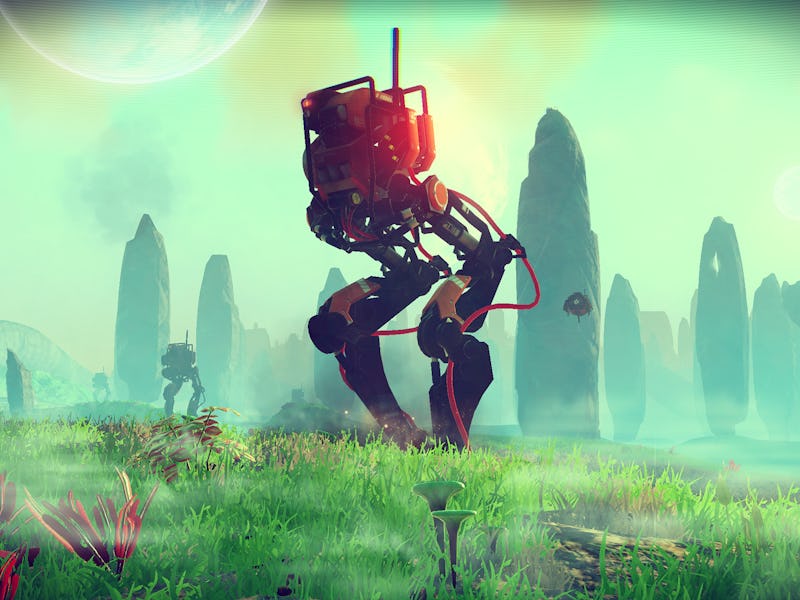African Surveillance Drones Have Brought 'No Man's Sky' Sentinels to Life
The Lindbergh Foundation's drone program wards off poachers and works similarly to the enemies of Hello Games' upcoming space game.

In No Man’s Sky, trigger-happy gamers using space buffalo for target practice will have to answer to planetary robot “Sentinels.” These weaponized drones are a de facto police to ensure no one in the procedurally generated universe causes virtual extinction. They’re not everywhere, but breaking the rules will activate a notoriety level that attracts escalating levels of Sentinel forces. Think of No Man’s Sky as if Isaac Asimov made Grand Theft Auto and you’re about there.
Director Sean Murray of Hello Games hinted to Kotaku that the Sentinels allude to a sinister, mysterious alien threat awaiting players. But that’s a video game. In real life, the Sentinels are used for good and were created by the Lindbergh Foundation, a nonprofit dedicated to preserving the environment with sophisticated man-made tech. Through its Air Shepherd Initiative introduced last year, the sky-savvy Lindberghs have taken to drones to ward off South Africa’s monstrous poachers.
“We had worked for a number of years with the Kenya Wildlife Service, helping them with airplanes and night vision goggles,” explains John Petersen, the current chairman of the Lindbergh Foundation. “I was in a conversation with a representative and he was telling me how pilots were getting shot at by poachers, and that poachers were also operating at night when [the KWS] couldn’t fly. It occurred to me there might be better ways to do this.”
Petersen challenged himself to find a solution, and three years later he did: Drones. Quieter and stealthier than normal planes and capable of being outfitted with infrared cameras, Petersen thought, eureka. “I ran around the country and talked to drone manufactures and found out it was a good idea.”
After two years of development and thousands of hours of test flights, the Lindbergh Foundation formally implemented Air Shepherd in 2015. Though the UAVs aren’t armed with lasers and they don’t look like bipedal William Gibson nightmares, they do have heat sensors and GPS systems which sends information to ground rangers to locate and divert poachers.
So far, it works. Petersen doesn’t have numbers to cite due to Air Shepherd’s infancy — following our phone call, Petersen went to South Africa to oversee the field teams and establish a measurable baseline, which is ongoing — but he knows its effectiveness. Two years ago, the organization’s South African partners UAV and Drone Solutions developed separate aircrafts and used them in anti-poaching situations. “They went through their own development process and started with quadcopters and other such things. They got approval from the government of South Africa, so they flew in Kruger National Park on two different occasions over six months and what they found was using their airplanes and tactics, poaching completely stopped.”
There are obvious differences between No Man’s Sky and Shepherd’s drones. Air Shepherd’s drones lack firepower while the game’s Sentinels are walking, floating death machines from hell. The reason stems from governments who are iffy about lethal drones in non-military sectors, and ammunition is a heavy load for these “little airplanes.” Plus, “you got to know what you’re looking at,” Petersen tells me, referring to the difficulty of identifying a poacher after dark. Night vision is sweet, but in tense situations no one can absolutely be sure they know what they’re seeing.
One variation of a Sentinel in 'No Man's Sky.' The machines have a real life analog in the Air Shepherd Initiative, which sends drones to ward off black market poachers in South Africa.
Still, No Man’s Sky could be foreseeing the future of surveillance and unmanned aircrafts, whose possibilities are as vast as the game’s 18 quintillion planets. Drones are already making breakthroughs outside wildlife preservation, but Petersen tells me it’s only scratching the surface: census work, fence check-ups, and monitoring hunters breaking and entering. Increasing autonomy means they can be used to “start their own thing.”
“There will be networks, so there will be a bunch of them connected, monitoring a whole area. If one of them finds or sees something of interest it communicates autonomously. This is just the beginning.”
Networks of autonomous drones that communicate? Sounds like something that’s going to exist in some form on June 25th rather than a few years down the road.
Ultimately, No Man’s Sky is just a video game and players engaging in galactic open season are doing it for fun, not black market profits. But Petersen thinks first-person shooting could be a first-person education in preservation.
“I have no way of knowing,” he admits, “but I think whether you’re in gaming or doing movies, that makes it easier to consider options to solve problems. I don’t think you can immerse yourself in any of these experiences, put them in your head, and not think it doesn’t make a difference in the way you look at the world.”
No Man’s Sky will be released for the PlayStation 4 and PC in June.